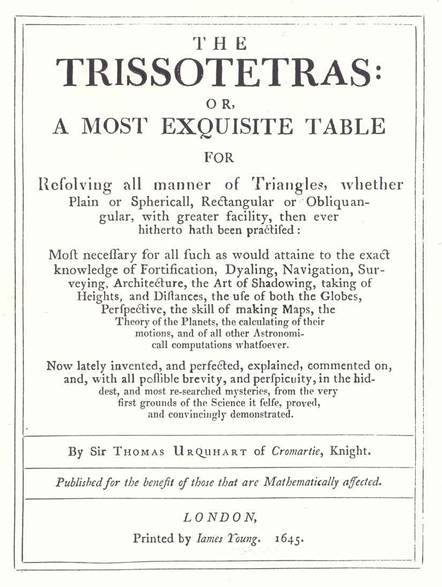
For those readers who had little or no difficulty in following the Anti-Newtonian, and who are therefore most likely feeling very smug and superior, allow me to introduce Sir Thomas Urquhart’s Trissotetras. This natty little work on trigonometry was originally published in 1645, but was reprinted in 1834 in the Maitland Club’s edition of The Works of Sir Thomas Urquhart. It is from this volume that I here quote a slab of page 99, on which begins the section with the memorable little title, “Of the Disergetic Loxogonosphericals there be in all Foure Figures: two Angulary and two Laterall”:
“The two angulary are Ahalebmane and Ahamepnare; the two laterall are Ehenabrole and Eheromabne.
The first angulary disergetic loxogonosphericall figure, Ahalebmane, comprehendeth all those problems, wherein two angles being given with a side betweene, either the third angle, or an opposite side is demanded, and accordingly hath two moods, the first whereof is Alamebna, and the second Allamebne.
Alamebna concerneth all those loxogonosphericall disergetic problems, wherein two angles being proposed, with an interjacent side, the third angle is required; which angle, according to the severall cases of this mood, is always one of the angles at the base, that is to say, in the termes of my Trissotetras, a prime, or next opposite, or at least one of the co-opposites to the perpendicular to be demitted. And therefore, conforme to the nature of the case of the datoquære in hand, and that it may the more conveniently fall within the compasse of the axiome of Nabadprosver, an angle by the first operation of this disergetick is to be found out, which must either be a double verticall, a verticall in the little rectangle, or a verticall, or co-verticall, as sometimes I call it, in one of the correctangles.
This much I have thought fit to premise of the prænoscendum of this mood, before I come to its Cathetothesis; because, in my Trissotetrall table, to avoid the confusion of homogeneall termes, though the order of doctrine would seeme to require another method, the first and prime orthogonosphericall work is totally unfolded before I speak any thing of the variety of the perpendicular’s demission, to which, owing its rectangularity, it thereby obtaineth an infallible progresse to the quæsitum; but, seeing in the glosse I am not to astrict my selfe to so little bounds as in my table, I will observe the order that is most expedient; and, before the resolution of any operation in this mood, deduce the diversity of the perpendicular’s prosiliencie in the severall cases thereof.”
In the introduction to the Maitland Club volume, it is written of the Trissotetras that “some apology may appear necessary, even to an Antiquarian Club, for reprinting a work apparently so unintelligible and useless.” The introduction goes on to quote a Professor of Mathematics in the University of Edinburgh, who was asked by a friend to give his opinion of the work. He wrote:
“I have looked at Sir Thomas Urquhart’s Trissotetras, but I hardly know what to think of it. The book is not absolute nonsense, but is written in a most unintelligible way, and so as never book was written before nor since. On this account it is truly a literary curiosity. There appears to have been a perverted ingenuity exercised in writing it, and I imagine that, with some patience, the author’s plan might be understood, but I doubt if any man would take the trouble; for after he had overcome the difficulty, there is nothing to reward his labour. I presume the object of the author was to fix the rules of Trigonometry in the memory, but no writer since his time has adopted his invention. Indeed, I do not observe the least mention of his book in the history of mathematical science. Yet, for his time, he seems not to have been a bad mathematician. Urquhart speaks in terms of great praise of Napier, yet not greater than he deserved. I infer from this, that he was well acquainted with the subject as then known. The book in question is certainly a curious, if not a valuable relic of Scottish genius in the olden time, and it is a good specimen of the pedantry and fantastic taste of the Author. If, therefore, by reprinting his works, it be intended to give a true portraiture of him, The Trissotetras should, on that account, and I see no better reason, again pass through the press.”
It was on the strength of this recommendation that the Maitland Club gave The Trissotetras a place in their volume.
It remains only to add that in another work of his, The Promptuary of Time, Sir Thomas attempted to trace his family tree right back to the Creation of the World!